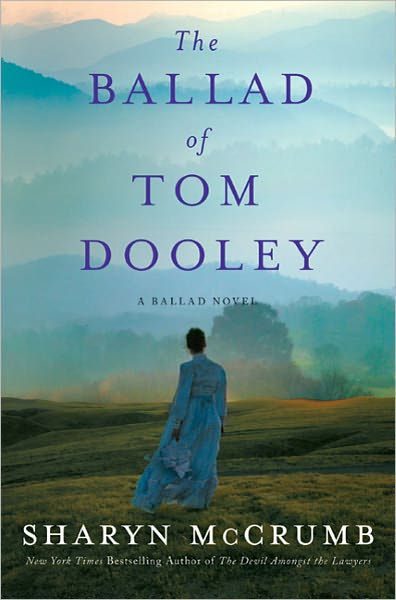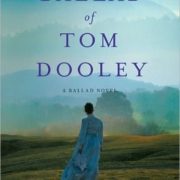THE BALLAD OF TOM DOOLEY – SHARYN MCCRUMB
TITLE: THE BALLAD OF TOM DOOLEY
AUTHOR: SHARYN MCCRUMB
PUBLISHER: THOMAS DUNNE BOOKS
RELEASE DATE: 2011
 Anyone who listened to folk music during the “Folk Music Scare” of the 1950s and ‘60s probably heard the Kingston Trio version of this song, a bouncy little murder ballad about killing a woman and ending up “hanging from a white oak tree.”
Anyone who listened to folk music during the “Folk Music Scare” of the 1950s and ‘60s probably heard the Kingston Trio version of this song, a bouncy little murder ballad about killing a woman and ending up “hanging from a white oak tree.”
Sharyn McCrumb, longtime mystery writer, has turned her gaze on this murder ballad, taking it back to its historical roots. While many historians and folklorists have examined this case in the past, her perspective as a mystery writer has given her different insights, much like those of the mystery writer in the Castle television show. Thus, a three-minute song becomes a 300-page historical novel. It’s hard to call it a mystery when everyone knows who was executed for the killing, but a mystery it is.
For those of you who only know it from the Kingston Trio version, sanitized and oddly altered in places, the “real” story was that of a young ex-Confederate soldier [Tom Dula, which is pronounced “Dooley,” for the same reason that Pauline is pronounced “Pearlene” in that region]. Tom was accused of murdering a young woman named Laura who was supposedly eloping with him. He and one of his other lovers [a married woman named Ann Melton] were eventually arrested and tried for the murder. He denied the murder, but once he was convicted and sentenced, he wrote a statement to clear the name of Ann Melton. His defense attorney was a famous politician and former soldier as well, a man named Zebulon Vance. After a long trial and longer appeals, Tom was hanged from a fresh built gallows, not a tree. Most of the other details in the song were added for rhyming purposes more than for historical accuracy.
Here’s where McCrumb’s insights took over. She noted the testimony of the trial, for which a partial transcript still exists. She also noted the local geography, and realized that several things didn’t add up. Among other things, why were the two supposedly eloping? They could have gotten married right where they were, or remained in some other form of relationship, and no one would have cared. The only person in the whole county who would have objected was Ann Melton. Even Laura’s father only wanted his horse back, when he thought that she had eloped while riding it. Tom had told friends he had no particular interest in marrying Laura, before the supposed elopement. As a further puzzle, why was their supposed meeting place somewhere not convenient for either one? In fact, Tom had no real motive for the crime, and the evidence against him was totally circumstantial and quite weak. Mostly, he just looked and acted guilty about something. Then, there was the mysterious and repeated reference to a local African-American, whose name kept coming up during the trial. What could a half-white ex-slave have to do with this twisted case?
By the end of the book, McCrumb has suggested alternate explanations to the murder case that will surprise even those who are familiar with the song and the story. Whether or not she has found “the” explanation is still open for conjecture, but she has certainly put together a set of circumstances which explains many of the mysteries surrounding the case.
The weaknesses of this story as a novel come from the fact that none of the central characters has a single redeeming feature. Well, other than Tom being a musician, perhaps. Otherwise, he was a lazy good-for-nothing. Ann was as self-centered as she was beautiful. Laura thought nothing of stealing her own father’s horse, even though she knew he couldn’t replace it, and she’s the nicest of the bunch.
The parts of the story told from the viewpoint of Zebulon Vance are oddly repetitive, as if there were unresolved editing problems. Much of the rest is told from the viewpoint of an unreliable and biased witness, Pauline Foster, a distant relative of both Ann and Laura. Some will be put off by her, but if you can ignore her general creepiness, McCrumb tells a good story through her.
For anyone interested in the way ballads are formed out of real events, or interested in the music and traditions of North Carolina, this will be well worth your time. If you enjoy it, you may find her other Appalachian fiction worth pursuing, as much of it is based on the songs and customs of the region. Look for such novels as The Songcatcher, She Walks These Hills or The Devil Amongst the Lawyers, or the short story collection Foggy Mountain Breakdown and Other Stories.
Nick Smith is coordinator of the Caltech Folk Music Society and on the board of directors of the California Traditional Music Society, as well as being a performing storyteller.













